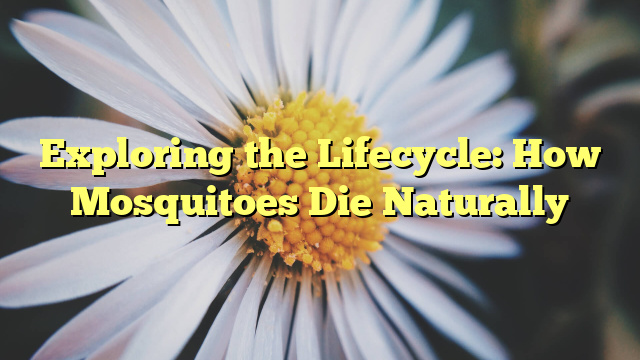Exploring the Lifecycle: How Mosquitoes Die Naturally
“`html
Exploring the Lifecycle: How Mosquitoes Die Naturally
Mosquitoes, often considered nuisances due to their itchy bites and role in spreading diseases, have a fascinating lifecycle that ends in natural death. Understanding how mosquitoes die naturally involves exploring their lifecycle stages, environmental factors, and natural predators. This article delves into the lifecycle of mosquitoes, highlighting the natural processes that lead to their demise.
Lifecycle of a Mosquito
The lifecycle of a mosquito is divided into four distinct stages: egg, larva, pupa, and adult. Each stage plays a crucial role in the development and eventual natural death of a mosquito.
Egg Stage
Mosquitoes begin their life as eggs laid on or near water surfaces. Depending on the species, eggs can survive for months before hatching when conditions are favorable.
Larva Stage
Once hatched, the mosquito enters the larval stage, living in water and coming to the surface to breathe. Larvae feed on microorganisms and organic matter in the water. This stage is vulnerable to various natural predators.
Pupa Stage
The pupa stage is a transitional phase where the mosquito does not feed but is still aquatic. It is during this stage that the mosquito transforms into its adult form.
Adult Stage
As adults, mosquitoes emerge from the water to begin their life in the air. Adult females seek blood meals to nourish their eggs, while males feed on nectar. The adult stage is where natural death most commonly occurs.
Factors Influencing Natural Death
Several factors influence the natural death of mosquitoes, including environmental conditions, availability of food, and predation.
Environmental Conditions
Extreme temperatures, humidity levels, and lack of water can significantly impact mosquito survival. Harsh conditions can lead to dehydration and death.
Availability of Food
Without access to blood meals (for females) or nectar (for males), mosquitoes cannot sustain themselves, leading to starvation and death.
Predation
Natural predators play a significant role in controlling mosquito populations. Predators include fish, birds, frogs, and other insects.
Natural Predators of Mosquitoes
Natural predators are essential in regulating mosquito populations and contributing to their natural death. Here are some of the most common predators:
- Fish: Many fish species consume mosquito larvae and pupae in water bodies.
- Birds: Some bird species, such as swallows and sparrows, feed on adult mosquitoes.
- Frogs and Tadpoles: Frogs eat adult mosquitoes, while tadpoles can consume larvae in the water.
- Other Insects: Dragonflies, beetles, and other predatory insects feed on mosquito larvae and adults.
Conclusion
The natural death of mosquitoes is a complex process influenced by their lifecycle stages, environmental factors, and predation. Understanding these factors is crucial for effective mosquito control and prevention strategies. By promoting the health of natural ecosystems and predators, we can help regulate mosquito populations and reduce the spread of mosquito-borne diseases.
Appendix: Lifecycle Stages and Lifespan
| Stage | Duration | Description |
|---|---|---|
| Egg | 48-72 hours | Eggs are laid on water and hatch into larvae. |
| Larva | 5-14 days | Larvae live in water, feeding and growing until they become pupae. |
| Pupa | 2-4 days | Pupae transform into adult mosquitoes. |
| Adult | Several weeks | Adults emerge, with females seeking blood meals and males feeding on nectar. |
“`This HTML article provides a comprehensive overview of the natural lifecycle of mosquitoes, including their stages of development, factors influencing their natural death, and the role of predators. It combines headings, subheadings, lists, and a table to organize and present the information effectively.

